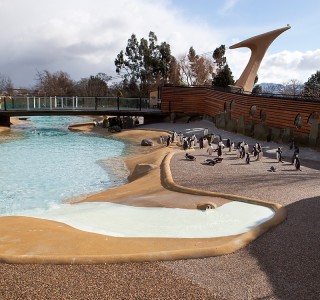The penguin pool at Edinburgh Zoo sprang a leak last year. It was losing 100,000 litres a day. Stirling-based specialist contractor Fraser Bruce was called in to offer a solution.
Initial discussions were followed up with some basic proposals that eventually led to a thorough site investigation of the original section of the penguin pool, the new section that was added approximately 20 years ago and the interface between the two.
It was established that the original 1960s section of the pool and its surrounding area were of an extremely varied construction with several layers of poor quality concrete contributing to the water loss issues.
The new pool and its surround were in much better condition but, as with the old section, the finished detailing was not good and obvious structural cracks and voids that would allow water loss were discovered below the water line of the pool.
Fraser Bruce was therefore contracted to carry out repairs that have effectively constituted a £750,000 redevelopment of the enclosure, which reopened on 13 March with the name Penguins Rock. The waterproofing works were designed and managed by contracts director Euan Bruce.
The zoo owner, the Royal Zoological Society of Scotland, commissioned Turner & Townsend as project manager and CDM coordinator. The project brought with it some unusual challenges. Work needed to be completed within a tight deadline ahead of the early 2013 penguin breeding season; and the neighbouring enclosure houses pandas, who are famously sensitive to unfamiliar and loud noises. Therefore panda-friendly non-impact methods had to be used at all times.
In the original section of the pool a full depth saw cut was formed approximately 300mm up the side wall from the pool base and also around the upper perimeter, some two metres beyond the water line. All traces of original concrete between the two saw cuts were removed to expose the subsoil base.
This base was excavated, where necessary, and then suitably compacted ready for a concrete topping. A reinforcement mesh was installed and hydrophilic joint strips were located at all junctions where new concrete would meet old.
The new concrete was positioned by concrete pump but was actually installed free-hand fashion to create a more natural looking, sweeping surface to the removed sections. This resulted in sections of concrete with thickness varying from 150mm minimum to more than 200mm in some locations.
A new layout was established for the old section of pool, including a slide for the penguins to play on. The remaining original areas of concrete in the pool were then prepared by grinding to remove traces of original failed fibre-glass membrane in preparation for new, fully-bonded waterproof and resin coatings. Here, too, work was constrained by the need to maintain panda-friendly noise levels.
Once cured, the junction between the new and old concrete was further sealed with a flexible, epoxy-bonded Hypalon bandage that can accommodate substantial movement between two substrates. This is the main waterproofing detail to prevent water loss at all potential movement joints in the `new’ structure. The hydrophilic strip provides a secondary “belt and braces” back-up.
Hypalon is, or was, a DuPont brand for a type of chlorosulphanated polyethylene (CSM) rubber. DuPont no longer makes it but others have adopted the name generically.

In the new section of the pool, where the concrete was essentially in reasonable condition, there was just some localised cracking and a few areas of surface debonding that required repair. The majority of the work in this section involved the preparation of the existing surface.
However, there were design details against rocks that created large voids to allow water escape. There was a requirement to re-design the edges of the sections where original stone features had been removed. This involved the same method of repair as had been carried out around the old pool, with saw cuts formed to provide neat edges, substrate levels adjusted, hydrophilic strips installed, new concrete placed and joints bandaged with Hypalon.
At the junction between the two pools, concrete was removed across the full breadth of the structure to a width of 800mm. The same process of substrate compaction, hydrophilic joint installation, concrete infilling and subsequent bandaging was employed. This creates a structural separation between the two sections of pool yet allows movement to occur without loss of water.
Once the base substrates had been reformed and prepared, they were ready for waterproof coating and the decorative elements. All new sections of concrete were prepared by grinding to create an exposed aggregate finish. This allowed the installation of a 2mm flexible waterproof slurry layer over the entire pool. It extends out of the water line to the perimeter upstand feature that was created to prevent contaminants from perimeter wash-down entering the pool. Once cured, the side walls and section extending to the perimeter feature were coated with two coats of a resin coating followed by a third coat that was blinded with the decorative aggregate sand to create the final appearance.
The floor sections of pool and areas that did not require the sanded surface received a two-coat resin application only.
All resins, coatings and other products were approved by the Drinking Water Inspectorate (DWI).
To create a more natural habitat Fraser Bruce developed an area for the penguins to nest, using a free-draining, resin-bound aggregate. The main requirement of this was to ensure that the penguins are not standing on permanently wet surfaces during their nesting periods. The 30mmthick application allows surface water to drain through to the original surface that was waterproofed with a single-coat resin membrane. The water then runs to existing drains rather than building up on the surface, as it did before.
The remaining perimeter areas were coated with a resin coating that was cast with a decorative sand to improve the appearance of the original concrete surround and create a beach effect.
Fraser Bruce also carried out concrete repairs on the perimeter walls, cable-securing features and manhole covers.
In addition, a new waterfall feature has been built with stones sourced at a local quarry. There is even a diving board for the penguins now, made from large flat stones also sourced at the quarry. All of these works were carried out using materials of sand/cement/SBR (styrenebutadiene rubber) plus standard concrete repair procedures.
As part of the final scope of works the balance tank chamber was coated as a precaution to prevent water egress. This was carried out with two coats of flexible cementitious slurry to all walls and the floor of the chamber.
Got a story? Email news@theconstructionindex.co.uk






